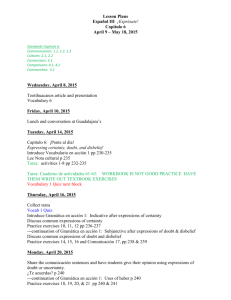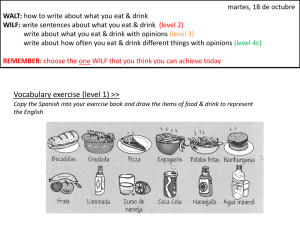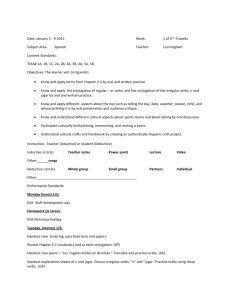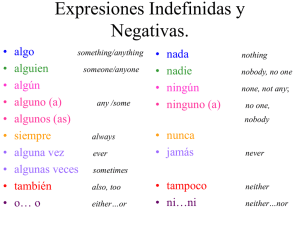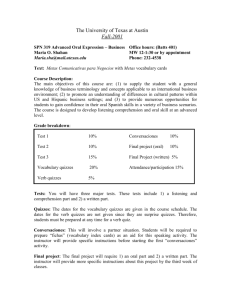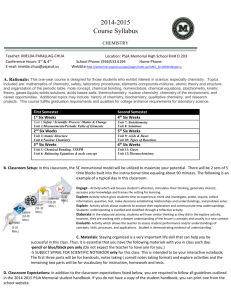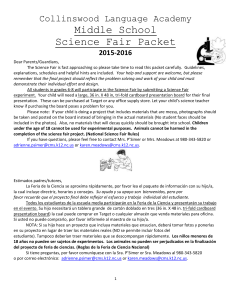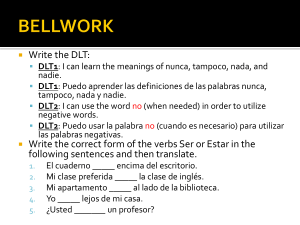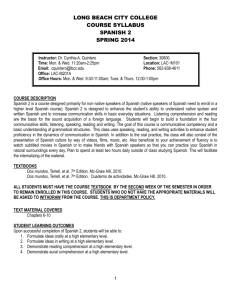Value of Homework
advertisement
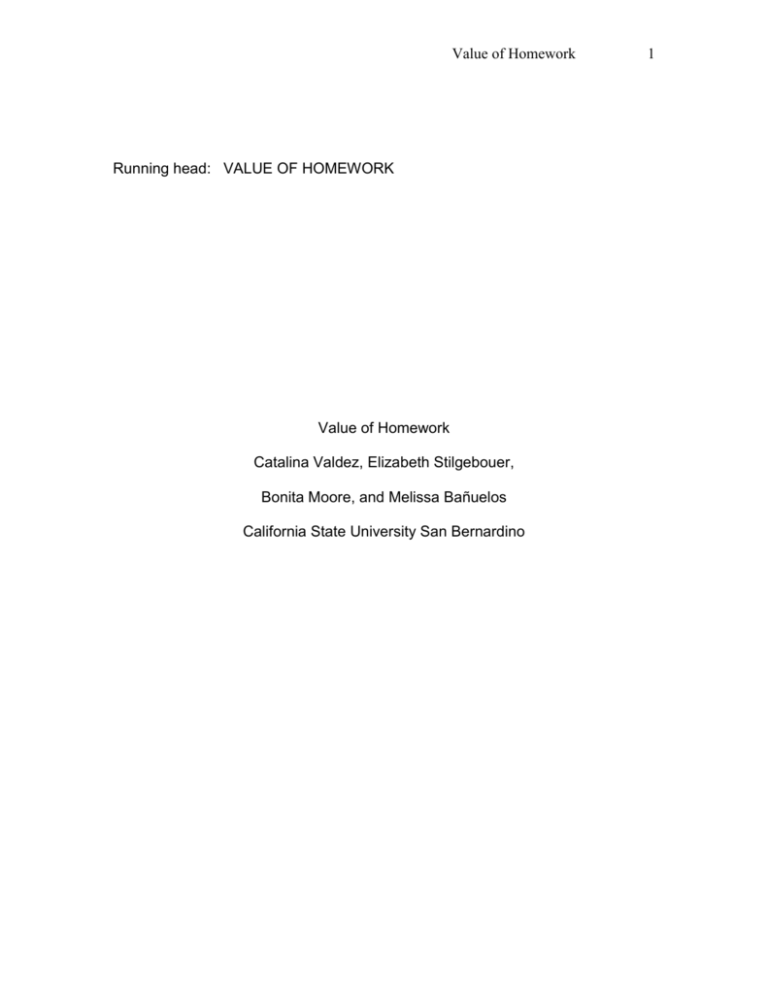
Value of Homework Running head: VALUE OF HOMEWORK Value of Homework Catalina Valdez, Elizabeth Stilgebouer, Bonita Moore, and Melissa Bañuelos California State University San Bernardino 1 Value of Homework 2 Abstract The issue of homework has been researched and hotly debated by educators, parents, and students over the last century. Arguments have developed for both positive and negative effects of homework on students’ academic and personal growth (Bruce, 2007). Homework is valued differently between teachers, parents, and students. This paper will show quantitative research results on the effects of the value of homework for 7th grade students in a public charter school. This study examines the teacher’s homework objectives and practices, the parents’ attitudes towards homework, and the students’ own perceptions and emotions. All of these attitudes and behaviors collectively join together to predict the effect they have on the students and their academic motivation. Teachers may use the findings in this research to better understand the effects of the value of homework on students’ academic and personal growth. Value of Homework 3 Value of Homework The value of homework varies among educators, students, and parents within different grade levels. Homework is generally defined as tasks which are assigned to students by their instructors that are meant to be carried out during non-school hours. (Bruce 2007) Those who value homework believe that it has many advantages to the academic growth of students and has become an important component within the educational system. It is seen by most educators and parents as a necessity for academic excellence (Baines). Teachers often assign homework as an opportunity to evaluate their student’s progress. Parents encourage homework because it allows them to see what their children are being taught. Students benefit from doing homework in nonacademic areas as well as developing academic skills (Baines & Slutsky, 2008). There are some disadvantages to students receiving homework when it is not valued. Researchers have also found that homework does not necessarily improve academic achievement. Homework can be detrimental to students and their social development (Baines & Slutsky, 2008). Homework can cause emotional stress that can lead to lower grades and poor academic performance. Social class level, family dynamics and students’ level of academic achievement in school if not considered when given homework can also have a negative effect on students’ grades (Trautwein & Ludtke, 2008). Repetitive homework which requires memorization or is not valued by the teacher can lead to boredom or frustration which might be the catalyst for a student to quit school (Shumow, Schmidt, & Kackar, 2008). Value of Homework 4 Keeping both opinions in mind, we felt it necessary to determine the level which homework is valued by educators, parents, and students. We can determine how much ones attitude and emotions affect the success of homework for the student and their family. Literature Review Academic Effects of the Value of Homework Homework is considered a necessity to academic success by many educators and parents. Fisher & Fry, (2008) conducted a survey sponsored by MetLife. The survey revealed that homework is viewed as important or very important by 83% of teachers, 81% of parents, and 77% of students. These percentages do not indicate the effectiveness of homework but rather how each party values homework. (Fisher & Fry, 2008) Student’s age and grade level must be considered when reviewing the connection between the value of homework and students achievement. Homework becomes increasingly important in the educational process as students increase in age. Research shows that there is almost no correlation between homework and academic achievement in elementary school, moderate correlation in middle school, and direct correlation in high school which may also be connected to how students at these different levels value homework. Value of Homework 5 Educators Teachers admit that they often use homework as a tool to evaluate a student’s knowledge of the subject matter as well as a method of classroom control (Shumow, Schmidt & Krackar, 2008). Homework is an extension of classroom instruction and is often assigned when the teacher falls short of class time to cover the subject matter. However, learning new concepts at home through homework can be detrimental to the student. Students may not have the ability to learn new lessons independently or may learn it incorrectly without the assistance of a teacher. The positive aspect of homework is that it can be used to reinforce learning at school. Homework provides students with time to reinforce learning and then apply it on their own. Once students have experienced an instruction, they should be expected to apply their knowledge independently. Homework can have an overall positive effect on a student’s level of achievement, improvement in educational skills, and social skills when structured properly (Haas, 2008). Quality, Type of Homework, and Teacher Feedback Homework can be assigned for academic and non-academic purposes. Cooper (1989) subdivides homework as follows: Academic: Practice homework (reinforce material from classroom instruction) Preparation homework (prepare for new classroom instruction or lesson) Extension homework(enables students to use learned skills to different contexts) Integration homework (project which applies several skills) Value of Homework 6 Non-academic: Personal development homework (improve behavioral skills) Communication homework (help develop communication skills with peers and family) Peer interaction homework (to improve team building) Policy homework (to fulfill mandated homework requirements by administration) Homework which is valued by the student can produce a positive experience in school, but it must be an appropriate kind of homework. The most important issue is how it is used, how much is given and the type of assignment given (Cooper). Cooper et al. (1998) linked student’s attitudes toward homework to the amount of assignments given. Researchers have found that students should be assigned no more than 10 minutes of homework per grade. High school students should have no more than 2 hours of homework a night. Anymore than the suggested amount of homework time becomes counter productive and the value of the assignment diminishes. Assignments that are consistent with daily lessons help to reinforce lessons being taught. Homework assignments should be related to subject matter so that students can identify with it and believe it is worth while. If homework is repetitive and not connected to daily instruction, students may consider it boring and are less likely to complete it (Shumow, Schmidt & Krackar, 2008). The quality of homework for middle school and high school students has a direct impact on the success of homework assignments. If students dread homework and see it as something to complete as quickly as possible, it is probable that it will have a negative effect on students’ motivation in school. (Haas, 2008) Students enjoy working on meaningful homework like research papers, preparing presentations and projects Value of Homework 7 rather than memorization or work sheet type homework. Completion of a science fair project or another type of project gives the student a sense of accomplishment and allows them to use the tools they have learned in class. Homework can increase students’ achievement and educational skills when structured properly and valued by teachers and parents. Students in elementary school are often assigned meaningless homework strictly for the development of good study habits, but research does not confirm this concept. Students tend to disconnect with homework and academic achievement if time spent on homework is excessive and unproductive. Many teachers assign workbook type repetitive homework assignments which are easy for the teacher to manage but boring for the student. The experience of consistently facing routine boring homework assignments in the name of developing good homework habits can have an adverse effect on students’ attitude toward important homework once in high school or college. Students’ enthusiasm in school and academic achievement is influenced by teachers’ response to homework and quality of assignments. Murphy and Decker (1989) found that most teachers who consistently checked and graded homework had higher amounts of students completing homework regularly. Teachers who check homework are instrumental in how students perceive the value of homework. Students need reinforcement on their academic progress and can easily loose interest if reinforcement is not provided. Data shows that the amount of homework students complete was related to their attitudes towards homework. Value of Homework 8 Socio-economic Levels of Students The effectiveness and value of homework is influenced by student’s socioeconomic level, family dynamics, students’ goals for the future, and the quality of homework assigned. Homework can increase the gap between academic achievement of affluent students and less affluent students. Students with well educated parents typically have conversations at the dinner table, in-house resources and shared experiences like travel and tutoring which underprivileged students do not. Students come from different living environments and socioeconomic levels which may or may not be conducive to homework success. For example, high achieving students typically come from more affluent families and have access to electronic tools, resources and a better living environment which is conducive to homework success. Single parent families which the parent may be at work during homework time, are considered to have a less conducive living environment for successful completion of homework. Students have the added pressure to help care for siblings and maintain household chores while their parent is at work. The needs of a single parent family often cut into homework time causing a student to stay up late to complete their homework or not to complete it at all. This is an example of a non-conducive homework environment for which the student may be penalized for incomplete or poorly done homework without regard to a student’s individual or family needs. There are many dynamics which must be taken into consideration when assigning and grading homework. If socio- Value of Homework 9 economic and demographic factors are considered when assigning homework, there should be no differences in the effect of homework on a student’s academic productivity. Non-academic Effects of the Value of Homework Students benefit non-academically by doing homework. Students in elementary school learn academic skills but more importantly develop social skills. If the development of students’ social skills is interrupted by excess school work or homework, students may become socially immature or underdeveloped. Teachers often use homework as a tool to balance classroom and life skills (Trautwein & Ludtke, 2008). Students who complete homework regularly develop many skills which will be used in higher education and life. Homework is viewed as a childhood job. Corno & Xu (2004) discovered that homework helped third graders learn responsibility and develop job related skills. Completion of daily homework can help a student develop time management skills, organizational skills, and increase self-esteem (Wagner, Schober, & Spiel, 2007). Children can become independent and self-sufficient adults through the process of homework. The assignment of homework enables students to develop independent learning skills. Students should be independent learners by the time they reach the end of middle school. Students also learn team building skills by working on homework projects which include several team members. If each member is assigned a task for the project, they will learn leadership skills like follow through, Value of Homework commitment, and pride in their own work. 10 These are all examples of non- academic reasons to value homework. Parents and Families Parent involvement in student’s homework and the effect on student’s achievement has been examined by Epstein (1988). Epstein found that time spent doing homework with more help from parents led to lower scores in reading and math. Cooper, Lindsay, & Nye (2000) also supported these results. They found that students who’s parents were actively involved in children’s homework led to lower test scores. Students in elementary school were found to be dependent on parents to help with homework rather than learning to complete it themselves. Parents, who do their children’s homework under the guise of helping their child, make it harder for them to perform at school on tests and class work. This is especially common among students with special needs like Attention Deficit Disorder or Dyslexia. Parents and children benefit from parental involvement with homework through reinforcement of the parent child relationship but little to no benefit academically. Homework can negatively impact the entire family. Homework takes away from family time and puts the parents in an adversarial role with kids. Students spend too much time in school and doing homework, and not enough time doing extra-curricular and family activities which is a common complaint of parents. Researchers have found that students in middle school and high school spend on average 3 hours per day doing homework (Baines & Slutsky, 2008). An Value of Homework 11 excessive amount of homework does not leave time for other activities, time to play or family time. Many families reconnect with each other during evenings as they prepare for the next day. When high-quality family time is disrupted or taken away, family members can become disconnected which can lead to dysfunctional families (Trautwein, & Ludtke, 2008). Parents also feel that students need time to relax. Students spend the majority of their day in school and working adults spend the bulk of their day at work. Students and adults need to relax from the day and should look forward to other activities. If students are not allowed time to relax, it is likely they may become resentful of their required daily tasks and choose to complete homework during class time or not at all (Shumow, Schmidt, Kackar, 2008). Pressure on Students Homework often leads to the satiation effect which is the time when students develop physical and emotional fatigue from pressures of excelling in school. Students develop their own coping mechanisms in dealing with family pressure and peer pressure during middle school and high school (Trautwein, & Ludtke, 2008). Middle school students are influenced more by their peers than their parents to complete homework. The good homework habits developed during elementary school which pleased parents and teachers, now become a liability to students and their peers (Shumow, Schmidt, & Kackar, 2008). Students may choose to do homework in secret or not at all, to avoid being seen as a “nerd” or “goody two shoes”. Value of Homework 12 Students in middle school tend to test the limits to determine how much if any homework they must do to receive passing grades. Students quickly learn that homework does not matter if teachers do not consistently grade the homework. The result is that students fail to value homework. Parents and teachers often pressure children to complete homework assignments which in turn create a negative view of homework in later years. Homework is considered to be instrumental to a student’s academic and social growth, according to some researchers, educators, parents, and students. Gaining entrance to college has become increasingly competitive causing high school students the need to gain an edge over other applicants. High School students are encouraged to earn above average grades and to participate in extra-curricular activities. Students are increasingly urged to excel academically and non-academically, and often become overwhelmed and stressed in the process. Students under a tremendous amount of stress either fail to complete their homework, cheat, or are forced to complete it during normal sleep hours. When a student is forced to resort to these survival methods, homework no longer has the effect it was intended (Haas & Parkes, 2008). Significance of the Proposed Study and Hypothesis After exploring some of our perceptions on the value of homework, we feel that our survey results will prove that students, parents, and teachers will value homework differently. We believe that various factors can effect how homework is valued by each of these groups. Teachers will have a high value for Value of Homework 13 homework because they usually assign homework based on the curriculum being taught in class. Parents will also value homework because they believe that homework will allow their child to succeed academically. Students will have a lower value for homework for many different reasons. Our hypothesis will demonstrate conflicting results among these three groups on the value of homework for the above reasons. The overall studies referenced herein project both positive and negative influences of homework on school students. The present study adds to the body of research showing how homework is valued based on several variables. The study explores how the student views homework by the amount assigned, how it is valued by the instructor, time spent on homework, and if the assignments correlate to the daily instruction. The quantitative statistical data should reveal that student’s value homework based on how they perceive their instructor and parents value of homework. It is important to study this issue because students are loosing interest in school and the drop out rate is escalating. The government is putting pressure on educators to lower the drop out rate and increase academic scores. Educators should know how their actions are perceived by students and parents and can use this information to make changes in their instructional approach if necessary. Value of Homework 14 Design and Methodology The design utilized for this educational research project is a quantitative design. The purpose was to examine the issue regarding how teachers, students, and parents value homework. We are interested in determining how homework is valued and how the various factors associated with homework such as attitudes, academic outcomes, and performance help received parent involvement, and teacher monitoring affects the way homework is valued. The participants were randomly selected in order to obtain a general sampling of students in a self-contained 7th grade classroom, the on-site teachers, and the students’ parents. An additional set of surveys were distributed to other students in order to increase the representative sample of students surveyed. The research study was conducted at an Inland Empire Charter School subsidized by the State of California. The first survey sample consisted of nineteen 7th grade students out of a total of twenty-nine students placed in a selfcontained classroom. The students consisted primarily of female students. The population of the classroom is 90% Hispanic from primarily low socioeconomic income families. The remaining 10% of students include: white and Samoan. The second survey sample consisted of sixteen 7th grade students who rotated through eight classes per day. The students consisted primarily of female students. The population of the classroom is 90% Hispanic and the remaining 10% of students include: white and Samoan. Value of Homework 15 There were 35 parents out of a total of 55 parents who completed and returned the parent survey. The primary language spoken in the majority of households is Spanish. There were 32 parents who returned the Spanish survey form and 3 parents who returned the English survey form. The teacher survey sample consisted of 3 teachers; 3 male; no female. There was one 7th grade teacher and 2 multiple grade teachers. The principal as well as the teachers support the conducting of this research project. They are interested in discovering through research methods how teachers, students, and parents value homework. To initiate this endeavor, a signed permission letter was obtained from the principal granting school participation in the educational research survey. Participation in the educational research survey is voluntary; therefore, a Research Study Parent Authorization Form was sent home to parents of students in English and Spanish to obtain permission for their child to complete a student confidential survey with age appropriate questions about homework and their experiences with homework. An informational letter accompanied the Research Study Parent Authorization Form to inform the parents about the undertaking of the research project, which would be conducted by California State University San Bernardino graduate students in the Masters of Education program. Parents were requested to participate by completing a parent survey comprised of 12 questions the same as teachers and students that were requested to participate. In order to expedite the return of the Research Study Parent Authorization Form on the following day Value of Homework 16 and to show appreciation, an incentive of a McDonald’s gift certificate was offered to students. The parents were informed that the information obtained is confidential and utilized solely for research and informational purposes; therefore, the names of parents, students, and teachers will not be divulged in the information disseminated to the public. In addition, parents were informed that any questions or interest in the survey results can be directed to the onsite research group project team member, Catalina Valdez. The research project was enthusiastically endorsed by the principal and teaching staff of the subject school. The teaching instructor for the self-contained 7th grade classroom utilized the research survey to be taken by the students as a teaching opportunity and tool by explaining why surveys are important and how the results of the survey assist researchers to answer some questions that they need answers to. The teacher further explained that this information can be used to improve their education and what kind of homework teachers provide to their students. Instruments The questions used in the survey to illicit the information needed to determine how homework is valued was established by the members of the educational research team. Essentially the same 12 questions were posed to the students, teachers, and parents in a manner appropriate for the particular population. A 4-point Likert-type scale was utilized for all constructs where 1 = NEVER and 4 = ALWAYS for questions 2 through 12. A 4-point Likert scale for Value of Homework 17 question 1 was used where 1 = ONCE A WEEK and 4= DAILY. For question 2, 1 = NONE and 4 = MORE THAN ONE HOUR. Questions were asked to determine frequency of homework, time spent on home, how often it is turned in, assistance received on homework, assessment of students’ attitudes, behavior and motivation towards homework, how homework is monitored and whether feedback is given to students in order to determine how homework is valued. A copy of each survey is located in the appendix. Procedure The study was conducted during regular lesson time in a self-contained classroom in the 2009 – 2010 school year. Participation was voluntary for teacher, students, and parents. All participating teachers, students, and parents were informed about the goals of the research study and assured that their data would only be used for the scientific purposes of this research study. All surveys were comprised of 12 questions that asked probing questions about how teachers, students, and parents value the concept of homework. The teacher surveys were distributed to all teachers who taught the 7 th grade. The student surveys were distributed to students for completion during regular classroom lesson time. The parent surveys were sent home to parents for completion and returned by the students of the participating parents. The first set of surveys were distributed and completed by students but the number completed was not adequate enough to obtain a sufficient sampling. As a result, a second set of the same survey was distributed to additional students to increase the representative Value of Homework sample of students surveyed. 18 A written report about the survey results was made available to the participating teachers and parents. The statistical program used was Excel to obtain the medium and mode. The advantages of using this procedure were that the program was easily accessible and had the mathematical functions needed to interpret our findings. The disadvantage of using this procedure was the lack of experience that the research team members had in utilizing the program to convert the survey results. (The treatment of subjects in this study was in accordance with the ethical standards of the APA principles “Ethical Principles of Psychologists and Code of Conduct”.) Presentation of Findings The survey results showed that students, parents and teachers perception of homework, how much is given and how it is handled appeared to deviate from one another. Student Survey - Mode Response Percentage 1 Question Daily 86% 2 More than 1 hour 43% 3 Always 60% 4 Always 57% 5 Sometimes & Often 46% 6 Sometimes 63% 7 Sometimes 49% 8 Always 59% 9 Often 41% 10 Sometimes 51% 11 Sometimes 46% 12 Never 43% Value of Homework Parent Survey - Mode Question 1 2 3 4 5 6 7 8 9 10 11 12 Question 1 2 3 4 5 6 7 8 9 10 11 12 Response Daily 1 hour Always Always Always Sometimes Sometimes Always Always Sometimes Never Always Percentage 86% 43% 77% 74% 43% 69% 66% 63% 63% 34% 54% 77% Teacher Survey - Mode Response Once, twce, daily 30 minutes Sometimes Often Sometimes, Often, Always Sometimes Always Always Often Always Always Often Percentage 33% 100% 100% 66% 33% 66% 66% 66% 66% 66% 100% 66% 19 Value of Homework 20 Question 1: How often do you receive homework? Participants Responses Percentage Students Always 86% Parents Always 86% Teachers Always 33% Parents and students equally perceived the amount of homework given and the amount completed as the same. Whereas teachers indicated that not all homework was complete and the amount given was much less than reported by students and parents. Question 2: On average, how much time do you spend on homework? Participants Responses Percentage Students More than 1 hour 43% Parents 60 minutes 43% Teachers 30 minutes 100% When asked how much time students spend on homework, 43% responded with more than 1 hour. Parents perceived that time spent on homework was 60 minutes, and teachers believed that students spent only 30 minutes. It is clear that the perceptions of the three participants were different which indicates that students felt that homework was a daunting task. Question 4: How often do you complete homework? Participants Responses Percentage Students Always 57% Parents Always 74% Teachers Often 66% Value of Homework 21 57% of the students report that they always complete homework, whereas 74% of the parents report that homework is always completed, which shows a communication gap between parents and students. Teachers report that 66% of the students often complete homework and no teachers report always completed. Question 11: Does your teacher write comments on your homework? Participants Responses Percentages Students Sometimes 46% Parents Never 54% Teachers Always 100% Researchers have found that feedback from teachers on a student’s homework is valuable and necessary for the student’s perception of the importance of the homework. Students report that 46% of their teachers sometimes gave written response to their completed homework. 54% of the parents felt that teachers never gave written comments on the students’ homework. On the contrary, 100% of the teachers reported always giving written comments on the homework turned in. Value of Homework 22 0% 6% 34% 1 2 3 4 60% QUESTION 3 Respondents were asked how often did they turn in homework? 60% of the students always turned in homework, 34% often turned in homework, 6% of the students turned in homework sometimes. In this question, the majority of the students value homework by turning it in. Value of Homework 23 16% 43% 12% 1 2 3 4 29% QUESTION 12 Students were asked if they like homework. Researchers found that 43% never liked homework, 29% liked homework sometimes, 12% often liked homework and 16% of the students always liked homework. It is apparent that the majority of the students do not like homework but they are completing the task and turning it in which shows that they do in fact value homework. Value of Homework 11% 24 17% 9% 1 2 3 4 63% QUESTION 6 Students were asked if they received help with their homework. The researchers found the 63% received help with their homework sometimes. 17% never received help, 11% always received help, and 9% often received help. These numbers are contrary to the expectations of the teachers which 33% expect the students to work independently. Students and parents both responded “sometimes” when asked if they receive help with homework or if they were frustrated with homework. Teachers responded that students should receive little help with homework and also acknowledged that students were frustrated while doing homework. Value of Homework 25 Discussion Although data was collected from three sources (students, teachers, and parents), the study cannot fully address the issue of causation, which is a limitation in many non-experimental research projects. There could possibly be explanations that emanate due to other variables that might affect the outcome of this research project. The researchers were not able to determine certain independent variables such as socioeconomic levels for each household, level of education of the parents, and marital status, as well as gender of the students and parents in the study. Further research is suggested to include independent variables which were not utilized in this study. Knowing and understanding these variables would lead to more concise information in the outcome of the survey. The researchers found that students’ value of homework was limited and that they completed homework out of necessity and requirement by their teachers and parents. The majority of students did not like doing homework and believed that they always turned it in. Parents expected their children to receive homework and believed their children when told that the homework was completed. Teachers were always obligated to assign homework either out of expectations of the parents or required by the school. Majority of the teachers reported that only small portion of the homework was completed and returned. Parents were found to value homework more than teachers and students. The hypothesis predicted that parents and teachers would have a high value of homework which is contrary to the results found by the researchers. The Value of Homework 26 research confirmed that students would have a lesser value of homework than teachers or parents. Value of Homework 27 References Baines, L. (2007). Learning from the world: Achieving more by doing less. Phi Delta Kappan Journal, 23-26. Baines, L. & Slutsky, R. (2008). Developing the sixth sense: Play. Educational Horizons, 97-100. Cooper, H. (1989a). Homework. White Plains, NY: Longman. Cooper, H., Lindsay, J.J. & Nye, B., & Greathouse, S. (1988), Relationships among attitudes about homework, amount of homework assigned and completed, and student achievement. Journal of Educational Psychology, 90, 70-83. Corno, L., & Xu, J. (2004), Homework as the job of childhood. Theory into Practice, 43, 227-233. Cosden, M., Morrison, G., Albanese, A.L., & Macias, S. (2001), When homework is not homework: After-school programs for homework assistance. Educational Psychologist, 36, 211-221. Fisher, D. & Frey, N. (2008). Homework and the gradual release of responsibility: Making “responsibility” possible. English Journal, 98 (2), 40-45. Haas, K. P. (2008). Questioning homework. English Journal, 98 (2), 14-15. Jackson, B. (2007). Homework inoculation and the limits of research. Phi Delta Kappan Journal, 89 (1), 55-59. Johnson, J.K., & Pontius, A. (1989). Homework: A survey of teacher beliefs and practices. Research in Education, 41, 71-78. Value of Homework 28 Mikk, J. (2006), Students homework and TIMSS 2003 mathematics results. Paper presented at the International Conference “Teaching Mathematics: Retrospective and Perspectives,” Tartu, Estonia. Murphy, J. & Decker, K. (1989). Teacher’s use of homework in high schools, Journal of Educational research, 82, 261-269. Sallee, B. & Rigler, N. (2008). Doing our homework on homework: How does homework help? English Journal, 98 (2), 46-51. Shumow, L., Schmidt, J. A., & Kackar, H. (2008). Adolescents’ experience doing homework: Associations among context, quality of experience, and outcomes. The community Journal, 18 (2), 9-28. Trautwein, U. & Ludtke, O., (2008). Predicting homework motivation and homework effort in six school subjects: The role of person and family characteristics, classroom factors, and school track. Journal of Learning and Instruction, 19 (10), 243-258. Trautwein, U., Niggli, A., Schnyder, I., & Ludtke, O., (2009). Between teacher differences in homework assignments and the development of students’ homework effort, homework emotions, and achievement. Journal of Educational Psychology, 101, (1), 176-189. Wagner, P., Schober, B., & Spiedel, C., (2007). Time students spend working at home for school. Journal of Learning and Instruction, 18 (002), 309-320. Wagner, P., Schober, B., & Spiel, C., (2007). Time investment and time management: An analysis of time students spend working at home for school. EducationalResearch and Evaluation, 14 (2), 139-153. Value of Homework 29 Appendix A Queridos padres, Como estudiantes del postgrado de la Universidad del estado de California de San Bernardino, estamos trabajando en nuestra maestría en el campo de educación. Como un requisito del curso, estamos llevando a cabo un estudio de investigación sobre el valor de la tarea para los estudiantes, padres y profesores. Nuestro estudio se centrará en los alumnos del séptimo grado. También la investigación se centrará en sus padres y profesores de los alumnos. Estamos interesados en aprender cómo los padres, estudiantes y los profesores valoran la tarea asignada. La tarea es una materia controversial en el área de educación y queremos saber su opinión sobre este tema. A fin de nuestro estudio de investigación para ser eficientes, necesitamos su ayuda. Hemos preparado un cuestionario separado para su hijo, los profesores, y padres que tiene preguntas adecuadas para cada uno de ustedes. Por las respuestas dadas en cada uno de los cuestionarios, podemos evaluar la pregunta “¿Cuál es el valor de la tarea?”. Su hijo y su maestro han completado sus cuestionarios en la escuela. Nos gustaría si usted pudiera completar el cuestionario en casa y regresar el cuestionario con su hijo el día siguiente. Cada estudiante será recompensado por devolver su cuestionario de padres a la escuela el día siguiente con un certificado de McDonald’s como un símbolo de nuestro agradecimiento. Nos gustaría informales que este proyecto de investigación y todos de sus componentes, han sido aprobados por el director Luna. La participación de este estudio es estrictamente voluntario para usted y su hijo. Toda la información obtenida será completamente confidencial por lo tanto, no necesitamos su nombre o el nombre de su hijo en el cuestionario. Si está interesado en los resultados o tiene cualquier pregunta con respecto a nuestro proyecto o la encuesta, por favor póngase en contacto con la profesora de segundo grado la Sra. Catalina Valdez, quien es también un miembro de nuestro equipo de investigación. Estamos muy satisfechos con este proyecto y entusiasmados en trabajar con usted y su hijo. Gracias de antemano por permitirnos la oportunidad de adquirir algunas ideas en la educación de su hijo. Estamos seguros que la información adquirida en nuestra investigación será fundamental para futuras investigaciones en la materia del valor de la tarea. Atentamente, Elizabeth Stilgebouer Catalina Valdez Bonita Moore Melissa Bañuelos Value of Homework 30 Appendix B Dear Parent, As graduate students from California State University San Bernardino, we are working on our Masters degree in the field of Education. As a course requirement, we are conducting a research study on homework and how students, parents, and teachers perceive homework. Our study will focus on 7th grade students, their parents and teachers. We are interested in learning how parents, students and teachers value the concept of homework. Homework is a controversial issue and we would like to know how you feel about it. In order for our research study to be effective, we need your help. We have prepared a separate questionnaire for you, your child, and your child’s teacher, which has an appropriate set of questions for each of you. By the answers given on each of the questionnaires, we will be able to evaluate the question, “How much is homework valued?”. Your child and his teacher have completed their questionnaires during class at school. We would appreciate it if you could complete your questionnaire at home and return it with your child to school the following day. We will be rewarding each student who returns their parents questionnaire to school the following day with a gift certificate from McDonalds as a token of our appreciation. Please know that this research project and all of its components has been approved by your principal Mr. Luna and is strictly voluntary for you and your child to participate in. All information obtained will be completely confidential; therefore, we do not need your name or your child’s name on the questionnaire. If you are interested in the test results or have any questions regarding our project or the survey, please contact the 2nd grade teacher, Ms. Catalina Valdez, who is also a member of our research team. We are extremely excited about this project and working with you and your child. Thank you in advance for allowing us the opportunity to gain some insight into your child’s education. We are confident that the information obtained in our project will lead to further research on the subject of homework. Sincerely, Elizabeth Stilgebouer Catalina Valdez Bonita Moore Melissa Bañuelos Value of Homework 31 Appendix C 5 de noviembre del 2009 FORMULARIO DE AUTORIZACIÓN PARA PARTICIPAR EN EL ESTUDIO Estamos coordinando un estudio de investigación sobre el valor de la tarea como un requisito para el programa de maestría en el campo de educación en la universidad del estado de California de San Bernardino. Agradeceriamos la participación de su hijo en nuestra investigacion con simplemente contestando un cuestionario confidencial de 11 preguntas apropiadas para su edad acerca del valor de la tarea. Por favor complete la sección siguiente y devuelvalo a la escuela el día siguiente. Si tiene alguna pregunta por favor de contactar a Ms. Valdez. Gracias, Ms. Valdez ============================================================== ________SI, ________________________________ tiene mi permiso para participar en el estudio de investigación sobre el valor de la tarea. ________NO, ________________________________ no tiene mi permiso para participar en el estudio de investigación sobre el valor de la tarea. Firma del padre ________________________________ Fecha: ___________________ Firma del estudiante ____________________________ Fecha: __________________ Value of Homework 32 Appendix D 7th Grade Directions: Answer each question honestly. Only choose on response for each question. Questions 1. How often do you receive homework? 2. On average, how much time do you spend on homework? 3. How often do you turn in homework? 4. How often do you complete homework? 5. How often do you copy homework from others? 6. Do you receive help to complete homework? 7. Do you feel frustrated while doing homework? 8. Does the homework help you better understand what you learned in class? 9. How often does your teacher monitor homework completion? 10. Does your parent or guardian check your homework? 11. Does your teacher write comments on your homework? 12. Do you like homework? Responses 1 Once a week 2 Twice a week 30 minutes 3 Three times a week 60 minutes None 4 Daily More than 1 hour Never Sometimes Often Always Never Sometimes Often Always Never Sometimes Often Always Never Sometimes Often Always Never Sometimes Often Always Never Sometimes Often Always Never Sometimes Often Always Never Sometimes Often Always Never Sometimes Often Always Never Sometimes Often Always Value of Homework 33 Appendix E Séptimo Grado Instrucciones: Contestar cada pregunta honestamente. Solo deben escoger una respuesta por pregunta. Preguntas Respuestas 1 2 3 4 1. ¿Con cuanta Una vez por Dos veces por Tres veces por Diario frecuencia recibes semana semana semana tarea? 2. ¿En cuánto tiempo Nada de tiempo 30 minutos 1 hora Más de 1 hora hace tu tarea diariamente? 3. ¿Con cuánta Nunca A veces Usualmente Siempre frecuencia entregas tu tarea? 4. ¿Con cuánta Nunca A veces Usualmente Siempre frecuencia terminas tu tarea? 5. ¿Con cuánta Nunca A veces Usualmente Siempre frecuencia copes la tarea de tus compañeros? 6. ¿Recibes ayuda para Nunca A veces Usualmente Siempre terminar tu tarea? 7. ¿Te sientes frustrado Nunca A veces Usualmente Siempre cuando hace tarea? 8. ¿La tarea te ayuda ha Nunca A veces Usualmente Siempre comprender mejor lo que has aprendido en clase? 9. ¿El maestro con Nunca A veces Usualmente Siempre cuánta frecuencia examina la tarea que este terminada? 10. ¿Alguno de tus padres Nunca A veces Usualmente Siempre o guardianes examina tu tarea? 11. ¿Tu maestro escribe Nunca A veces Usualmente Siempre comentarios en tu tarea? 12. ¿Te gusta hacer Nunca A veces Usualmente Siempre tarea? Value of Homework 34 Appendix F 7th Grade Directions: Answer each question honestly. Only choose on response for each question. Questions Responses 1 2 3 4 1. How often do you Once a week Twice a week Three times a Daily assign homework to week students? 2. How much time do you None 30 minutes 60 minutes More than 1 hour expect your students to work on homework? 3. On average how often Never Sometimes Often Always do your students turn in homework? 4. How often do your Never Sometimes Often Always students complete their homework? 5. How often do you catch Never Sometimes Often Always students sharing homework assignments? 6. Do you expect students Never Sometimes Often Always to receive help with their homework at home? 7. Do you feel obligated to Never Sometimes Often Always assign homework? 8. Does your homework Never Sometimes Often Always assignments correlate with your course curriculum? 9. How often do you Never Sometimes Often Always monitor homework completion? 10. Do you expect Never Sometimes Often Always parents/guardians to check students’ homework? 11. Do you give feedback Never Sometimes Often Always to students on their homework? 12. Do you like assigning Never Sometimes Often Always homework? Value of Homework 35 Appendix G 7th Grade Directions: Answer each question honestly. Only choose on response for each question. Questions Responses 1 2 3 4 1. How often does your Once a week Twice a week Three times a Daily child receive homework? week 2. How much time does None 30 minutes 60 minutes More than 1 hour your child spend doing homework? 3. How often does your Never Sometimes Often Always child turn in their homework? 4. How often does your Never Sometimes Often Always child complete their homework? 5. Are you aware whether Never Sometimes Often Always your child completes their own homework or copies from other? 6. Does your child receive Never Sometimes Often Always help to complete their homework? 7. Does your child feel Never Sometimes Often Always frustrated when doing his/her homework? 8. Does homework help Never Sometimes Often Always your child better understand what they learned in class? 9. How often does your Never Sometimes Often Always child’s teacher monitor the completion of their homework? 10. Do you check your Never Sometimes Often Always child’s homework? 11. Does your child Never Sometimes Often Always receive comments on their homework? 12. Do you like your child Never Sometimes Often Always to receive homework? Value of Homework 36 Appendix H Séptimo Grado Instrucciones: Contestar cada pregunta honestamente. Solo deben escoger una respuesta por pregunta. Preguntas 1. ¿Con cuánta frecuencia recibe tarea su hijo/a? 2. ¿Cuánto tiempo dura su hijo/a haciendo tarea? 3. ¿Con cuánta frecuencia entrega la tarea su hijo/a? 4. ¿Con cuánta frecuencia completa la tarea? 5. ¿Usted se da cuenta si su hijo/a hace su propia tarea o copea de otros? 6. ¿Su hijo/a recibe ayuda para completar su tarea? 7. ¿Su hijo/a se siente frustrado/a cuando hace la tarea? 8. ¿La tarea le ayuda a su hijo/a ha comprender lo que ha aprendido en clase? 9. ¿Con cuánta frecuencia examina la tarea el maestro/a de su hijo/a? 10. ¿Usted examina la tarea de su hijo/a? 11. ¿Su hijo/a recibe comentarios en su tarea? 12, ¿Le gusta que su hijo/a reciba tarea? 1 Una vez por semana Respuestas 2 3 Dos veces por Tres veces por semana semana 4 Diario Nada de tiempo 30 minutos 1 hora Más de 1 hora Nunca A veces Usualmente Siempre Nunca A veces Usualmente Siempre Nunca A veces Usualmente Siempre Nunca A veces Usualmente Siempre Nunca A veces Usualmente Siempre Nunca A veces Usualmente Siempre Nunca A veces Usualmente Siempre Nunca A veces Usualmente Siempre Nunca A veces Usualmente Siempre Nunca A veces Usualmente Siempre

